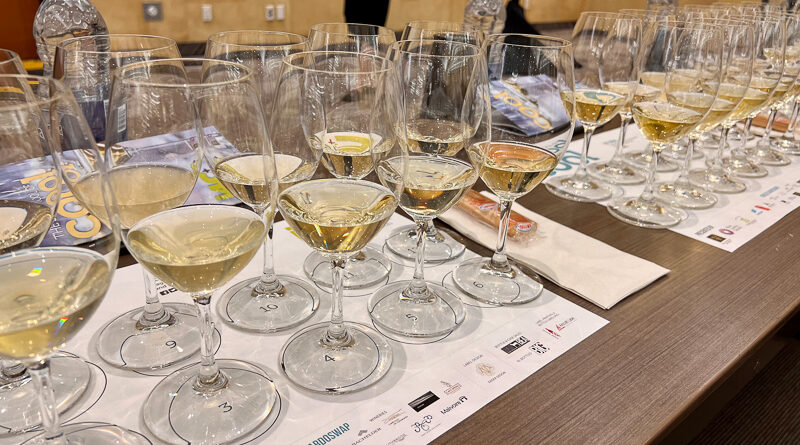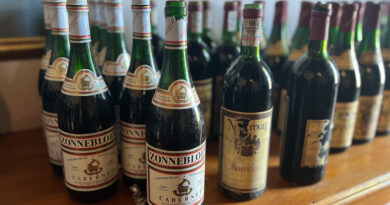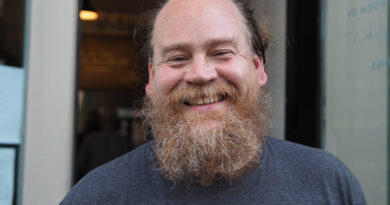The School of Cool 2022: exploring Chardonnay at an international conference in Canada’s Niagara region, with Andrew Jefford and The Great Chardo Swap
The School of Cool, the Friday seminar of the International Cool Climate Chardonnay Celebration (i4C), held each year in Niagara, Canada, was back after a 2 year Covid break. And we were lucky that Andrew Jefford was the keynote speaker. He gave a really poetic yet meaningful address to the assembled crowd, based around a metaphor.
‘Imagine wine is music,’ Andrew begins. ‘Wine is a sort of music, it weaves patterns of scent and flavour rather than sound…It touches us intellectually and sensually, just like music.’

Andrew added that there’s a language of wine, just as there is with music. ‘We learn how to unlock the subtleties of both.’
In the case of wine, the place composes its ‘music’: but, he adds, ‘the strange thing about this music is that it’s silent without the human.’ He reminded us that for most of the last 20 000 years Montrachet was just a patch of forest. ‘Viticulture realised its potential and brought the music into being.’
And, of course, there is no music without the instruments and performers. ‘The struggle for winemakers is to listen to the music that is silent – and bring it into being,’ Andrew says. ‘You have to ask the place what sort of wine it wants to make – you need to be a hill whisperer or a soil diviner.’ Where wine has already been made for a while, it is easier. ‘Wine traditions help hugely because others have listened first.’
But we have a problem: climate chaos. ‘The shock of global warming is changing all the instructions and the music of many places is sliding out of tune,’ says Andrew. This is a major concern, and some response is needed on the part of wine growers to get that tune back. What will it be? New varieties? Moving vineyards?
Back to the music metaphor. Here, the instruments are grape varieties. Often, the very greatest places will only reveal themselves with some varieties or blends of varieties. You can plant Gamay in Romanée-Conti and it would probably make a lovely wine. ‘But I doubt it would be sublime,’ says Andrew. And he thinks that the better the site, the more the instrument matters.
Lots of different varieties exist, but some are better or more versatile than others. ‘You could fill a warehouse with instruments, and in the very centre of the warehouse is the most useful and most adaptable instrument of all – it’s a piano. The piano is suited to many different sorts of music and that variety is Chardonnay.’ But the problem with being adaptable that folks take you for granted: and we have been guilty of often taking Chardonnay for granted.
Andrew recalls when he first came to the Niagara wine region. ‘I tasted everything
The high-pitched ice wine chorus, The soulful Rieslings.’ And Cabernet Franc and Gamay, and Pinot Noir. ‘But I didn’t pay much attention to Chardonnay: It is what everyone did.’ He went home, then later came back and tasted more, then went home again. After some time, he says it was the Chardonnays that he was most thinking of: ‘the quiet compelling Niagara wines in which the variety had receded. These were the wines in which the variety had ceased to come first – I could think about Niagara instead.’
‘Great winemakers strive for nothing except invisibility – this is the music of place.’
So Chardonnay is the piano. ‘How much is Chardonnays repertoire predicated on temperature?’ asks Andrew. ‘Is it cool or nothing?’
Generally speaking, Chardonnay does better in cooler climates, but it’s not solely a cool-climate variety. ‘The warmer the location the greater the risk that the variety will throw the place into the shadow.’
He poses another question: ‘Is it teasing inarticulacy that we need to look for?’ And then makes a distinction between the shy and the mute. ‘In warm regions you can achieve inarticulacy by early harvesting,’ says Andrew. But these wines ‘might be mute and undeveloped – the fruit never achieves resonance.’ Certainly, this is a risk in warmer regions, but many are successful in getting resonant wines by perfectly judged harvesting and cellar restraint. Chardonnay is an instrument on which you can play many forms of music, and the vine is a forgiving and adapting plant.
An final thought? ‘Chardonnay came into being in cool climates but it has moved beyond those as a servant of place.’

The Great Chardo Swap
The idea for the Great Chardo Swap – 12 winemakers making 12 Chardonnays from two vineyards – came from Dr Belinda Kemp. Belinda is a researcher at Brock University who did her PhD in New Zealand, and the inspiration for this initiative was a similar project in New Zealand with Riesling.
The plan was hatched: each of 12 winemakers were to get 300 litres of juice from one of two vineyards: Thirty Bench in Beamsville Bench, representing the west of the Niagara Peninsular, and Montague in Four Mile Creek, representing the east. The grapes were pressed and they each came to collect their juice, plus a separate container full of some pressings. This project began with the 2017 vintage. The questions to be addressed include w hat does the place bring to the table? And what is the role of the winemaking team?
We tasted the resulting wines blind, and here are my notes and scores as written. This session was well moderated by Chris Waters of the Globe and Mail.

2017 Thirty Bench Chardonnay from Craig McDonald, Trius
15 months in neutral French oak and full malolactic (which they don’t normally do). Textured, quite bright, mealy notes, nice pear fruit with a bit of spiciness. Bright with a nice lemony finish. Very fruity and a bit rounded. Quite technological. 89/100
2017 Thirty Bench Chardonnay by J-L Groux, Stratus
JL put the juice in a barrel and it took two weeks for anything to happen. It was growing mould – a thick coat of fur – but not fermenting. So he moved it to a warm place and fermentation began. There was some volatile acidity initially but it has clearly blown off. It was then bottled with its fine lees – ‘a technique I really enjoy doing,’ says JL Groux. Brightly aromatic with nice complexity: citrus, fine spices, a hint of apple. The palate is fresh with lovely grainy detail and some mineral notes, with a touch of salinity. Such a lovely expressive wine. 94/100
2017 Thirty Bench Chardonnay by Amélie Boury, Chateau des Charmes
Bright and fruity on the nose with some tangerine and lemon character, leading to an open, fruity palate. Has some appley character, too. Supple and quite easy. 89/100
2017 Thirty Bench Chardonnay by Ann Sperling at Southbrook
Wild ferment, old French oak 300 litre barrel. This is interesting: orange peel and lemon with some nice acidity. Bright and expressive with pure fruit and some nice mineral notes. Has mid-palate volume. Fruit-driven and pure. 91/100
2017 Thirty Bench Chardonnay by Nick Gizuk at Inniskillin
Nutty, mealy nose with citrus and spice, and some liquorice. There’s quite a bit of sophisticated oak here in the mix. Woody and intense, with a citrus core. 91/100
2017 Thirty Bench Chardonnay by Fabian Reis, Ferox
Full barrel fermentation with a 225 litre Radoux barrel, fourth fill, wild ferment, full malo, then after a year finished in stainless. Quite nuanced and delicate with sweet pear and mandarin fruit, with some lemony brightness and fine spiciness. Sweet fruit to the fore. Lovely fine-grained structure. A pretty wine with lots of fruit. 90/100

2017 Montague Vineyard Chardonnay by Gabe DeMarco, Cave Spring
Built texture with oxidation, growing flor for a couple of months. 50% inoculated stainless, 50% wild in barrel, and then blended and put to barrel. First SO2 was 15 months and then it was bottled unfiltered and unfined. Nice texture here: it’s a bit grainy and saline with some crystalline citrus. There’s a bit of soul to this: fine toast and meal, and lovely fruit but with some real complexity. 93/100
2017 Montague Vineyard Chardonnay by Casey Kulczyk, Westcott
Very clean and fruity with nice complexity: it’s a bit mealy and spicy with cashew and hazelnut as well as lemon and pear fruit. Shows a really nice mouthfeel with some detail. 92/100
2018 Montague Vineyard Chardonnay by Thomas Bachelder
This isn’t a typo. Thomas didn’t have his 2017. Perhaps he lost the barrel? Supple, midweight and fruity with nice fruit. Tangerine and lemons, with nice clarity. Supple, easy and showing lots of fruit. 89/100
2017 Montague Vineyard Chardonnay by Shiraz Mottiar
Had a stainless steel barrel, put some dry ice in it. But didn’t bring a separate bucket for pressings. ‘For me, most of the winemaking has already happened,’ says Shiraz, because there’s no connection with the vineyard in this project. Went into barrel, inoculated, looking for a clean, pure style. Quite light and lemony with some mandarin and peach, as well as some wood spice. Linear with good acidity and nice taut personality. Has a touch of salinity. 92/100
2017 Montague Vineyard by Emma Garner, Thirty Bench
Very fruity and expressive with mandarin, grapefruit and melon notes. Bright and expressive with a juicy quality and very pretty fruit. Has a tapering tangerine finish. 90/100
2017 Montague Vineyard Chardonnay by Lawrence Buhler of Henry of Pelham
Concentrated and mealy with some bacon notes as well as sweet pear and citrus fruit. Such a distinctive wine with some bacon notes really dominating this wine. 88/100
I think it’s clear from my notes that the role of the winemaker is a very important one with Chardonnay because it affects the wine flavour so much.

We also did a Chardonnay tasting, with one wine from each participating winemaker.
Trius Showcase Chardonnay 2020
Textured, pure and rounded with sweet pear and peach fruit with a soft mid-palate. Fruity, rounded and quite soft. Has nice balance with a good concentration of appealing fruit. 90/100
Cave Spring Vineyard Chardonnay 2019
Complex, spicy and a bit toasty with nice depth of pear and peach fruit and some lovely spicy framing. Has good complexity, balancing fruit richness with freshness. 93/100
Stratus Chardonnay 2017
Bottled with lees. Cloudy, mealy and spicy with lovely texture. Ripe pear and peach fruit with lovely weight in the mouth. It’s quite mealy and expressive. 93/100
Westcott Chardonnay 2020
Rounded, mealy, nicely textured with fresh citrus and pear fruit. Nicely complex with a fine spicy edge. Has a good balance between the richer notes and the freshness. 92/100
Château des Charmes Paul Bosq Chardonnay 2020
Linear and textured with nice balance. It’s fresh and lively with a lovely mineral edge to the lemon and pear fruit. Restrained with nice detail and intensity. 90/100
Bachelder Wismer Foxcroft Chardonnay 2018
Textured, restrained and with nice complexity, showing pear, ripe apple and citrus fruit with fine spices and a touch of meal. Nicely detailed with good balance and presence. 93/100
Southbrook Laundry Vineyard Chardonnay 2020
Complex, mealy, some fine toasty notes and a nice grainy structure as well as citrus and pear fruit. Lovely balance with a fine spicy framing. 92/100
Malivoire Mottiar Chardonnay 2019
Concentrated and fresh with nice pithy pear and citrus fruit. Good intensity here with taut citrus on the palate and some fine spicy notes, and nice acidity. 92/100
Inniskillin Reserve Chardonnay 2020
Rich with some pineapple and peach notes and nice grainy texture. Lovely weight with a nice depth to it. Has some pear and peach on the finish: very attractive with good weight. 91/100
Thirty Bench Small Lot Chardonnay 2020
Fruity and expressive with nice weight. There’s some freshness with a bit of lemony brightness, and appealing mandarin and white peach, as well as some melon. Lovely fruity depth with nice freshness and complexity. 92/100
Ferox Estate Vintages Chardonnay NV
A complex wine with some richness, some melon, pineapple and apricot. Has lots of fruit with some depth, and notes of liqourice and spice, finishing fresh. Such a distinctive Chardonnay covering a broad dynamic range of flavour. 93/100
Henry of Pelham Estate Chardonnay 2020
Lovely balance and delicacy here with fine spicy notes and a bit of mineral lacing and nice pear and peach fruit. Very expressive with fine fruity notes and great balance. 93/100
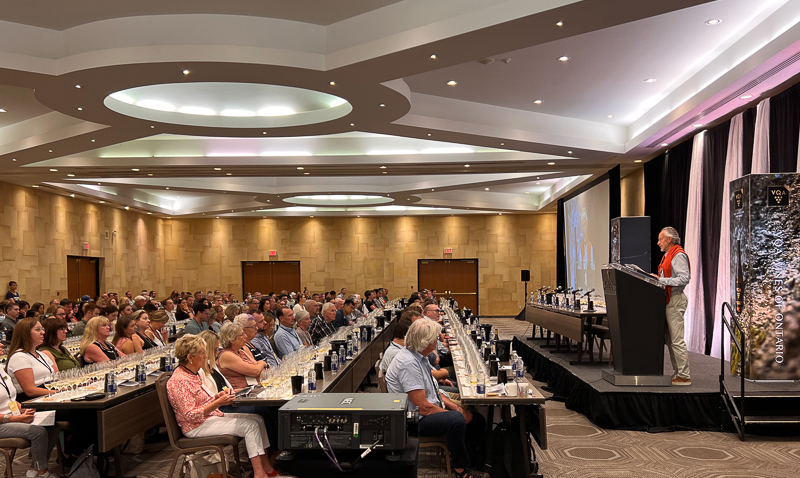
Redefining cool
In the final session, six winemakers presented their wines. Climate change is a reality, and winegrowers are a perfect canary in the cage, says Andrew Jefford who introduced and moderated this session. There’s nothing new about climate change on the planet – for 85% of earth’s history there has been no ice at the pole. But what is striking is the speed of change and the extinction episode that this speed of change is bringing about. We are children of the interglacial, but we are flipping into a greenhouse world. It’s a problem for present day planetary life, but not necessarily the planet.
Cool is on the move, and up-latitude. This could be good news for Canada and the UK, but it’s tougher for southern hemisphere winemakers, where further south means the great southern ocean.
Of course, a great vineyard location is more than a latitude. The greatness of the Cote d’Or or Medoc is in their present locations. They are unique, and you can’t just move them north or to higher ground. And altitude can’t entirely compensate for latitude because as you go higher, everything changes. Cool climate perhaps needs to go from a passive concept to being an active concept.
How do we redefine cool for a warming world? How do we craft wines so they can retain inner freshness?
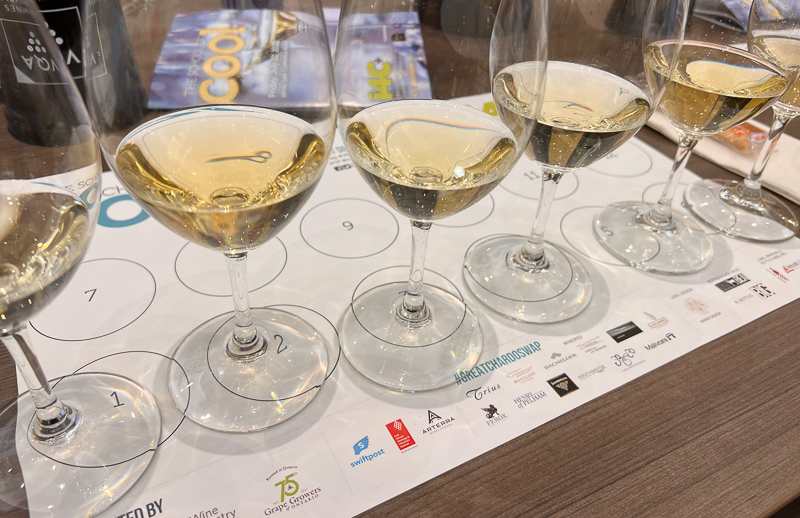
First up, Danielle Coetsee, white winemaker for Boschendal. Boschendal has focused on cooler growing areas. Elgin is one: it’s higher altitude. Proximity to the ocean is another cooling factory. Elgin is 15 km from the ocean in a high-altitude basin, and this wine comes from 310 m.
Boschendal Elgin Chardonnay 2019 South Africa
This is barrel fermented in 300 litre barrels and 2500 litre foudres. Taut, bright and vivid with bright citrus fruit, a touch of pineapple and some pithy hints. Nice acidity here with well-integrated oak. Finishes nutty, spicy and precise. 93/100
Next, Sandrine Baud, who took over the domaine Baud five years ago with her brother in the heart of the Jura. They have 25 ha of vines. When her grandfather was running things they harvested in the middle of October and they now start in the middle of August (for sparkling). They have warmer winters and now it’s a problem because warmer winters lead the vines to start earlier, and then they get frost issues. In 2017 they lost 70% of their crip to frost, then in 2019 lost 50%, and in 2021 lost 80% of the harvest. ‘This is becoming a huge problem for us,’ she says, ‘and the specialists say it will get worse, with warmer winters. We tried some solutions: we burned straw but it didn’t really work.’ The smoke is supposed to protect the buds when the sun rises. The bougies are too expensive to use, and they can only protect down to -6, whereas this year they got -11 C. ‘We also have to face a warm summer, but we don’t lack water yet. Ave is 1200 mm of rainfall. They have 54 old varieties from the Jura, and some of them are interesting because they keep a lot of freshness. Some of them aren’t permitted in the AOC. But they planted 50 vines of one of them – they have been doing microvinifications.
Domaine Baud Cuvée Flor Chardonnay 2020 Côtes du Jura
Powerful, lively and spicy with concentrated tangy citrus and pear fruit with some saline notes and tangy apple and lemon on the finish. Lovely intensity here with some crystalline citrus fruit. 94/100
Next up, Joseph Ryan from Ernest Vineyards, which is now 10 years old. It’s based in the Sonoma Coast, near the ocean. It’s part of the new AVA called the West Sonoma Coast, which is all close to the Pacific. It’s very cool here.
Ernest Joyce Vineyard Chardonnay 2019 Sonoma Coast
400 ft elevation close to the sea. Goldridge: fine sandy loam soils. Powerful and intense with intense pineapple fruit with some peach and lime. Really vivid with bright citrus fruit and good acidity: intense and expressive, with a lot of weight but also lots of freshness. 93/100
Next, Nikki Callaway of O’Rourke in Lake Country in the Okanagan. She’s been in the Okanagan for 10 years. ‘It has been exciting to see the adaptation and education the Okanagan has gone through,’ she says. 50 years ago the Okanagan decided to rip out its hybrids and plant the 12 most common varieties. But now they are starting to replant some hybrids and also plant new varieties. She’s based in Lake County, the most northern part of the Okanagan. They have 110 acres of vines here and don’t buy from growers. The winery and vineyards are brand new.
O’Rourke Family Estate Chardonnay 2020 Lake Country, Okanagan
Debut vintage. Vines were 3-6 years old. Wild yeast (no commercial yeasts have ever been used in the facility). This is balanced with fine spices and pear and peach fruit. It’s quite textural with good balance, showing nice mid palate with nice stony detail. It’s fresh and balanced with good weight in the mouth. 93/100
Patricia Tóth, winemaker at Planeta in Sicily, joined by zoom. They have five wineries around the island. In the last 17 years they have opened four. Patricia’s job has been focusing on the new wineries that open.
Planeta Chardonnay 2020 Sicily, Italy
This is from 2 vineyards. One at 250-270 m planted in 1985 with fossil-rich soils and 650 mm rain a year. The other is at 450 m with calcareous soils in a windy spot planted in 1999. This is textured with nice depth and lovely pineapple and citrus fruit showing some peachy richness and nice creamy texture. There’s depth and ripeness, but also some freshness. Finishes bright and taut with some subtle oak influence. 93/100
Finally, Alex Baines of Hidden Bench. He’s a brit who’s been in Niagara for 10 years. The Hidden Bench wines, from the Beamsville Bench in Niagara, are superb.
Hidden Bench Felseck Vineyard Chardonnay 2019 Beamsville Bench, Niagara
This has lovely elegant but ripe pineapple and pear fruit with some lovely citrus character. Some lime and chalk notes with a touch of salinity (7.5% active limestone in the soil) and keen acidity. Juicy, lemony and fine with great balance. 94/100

